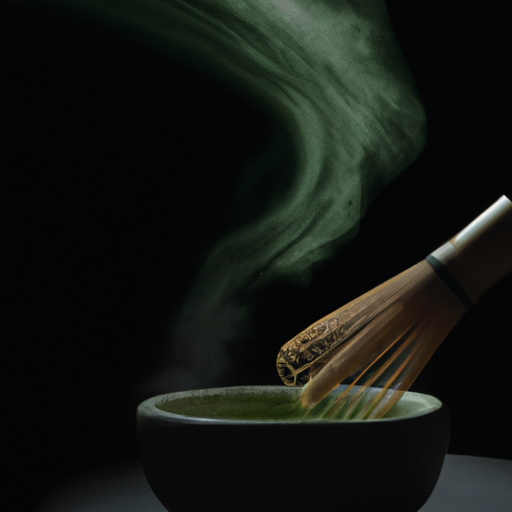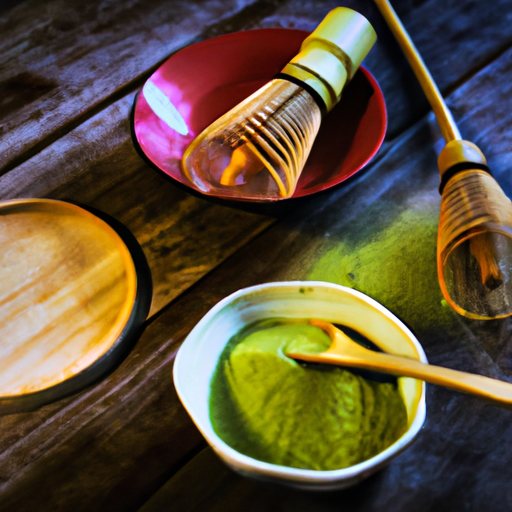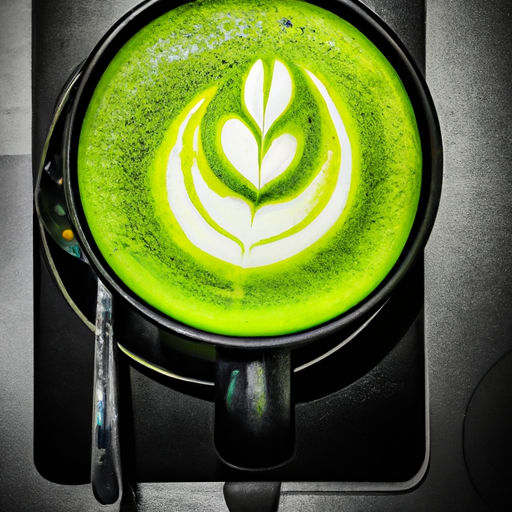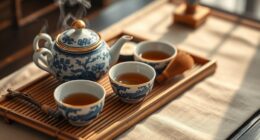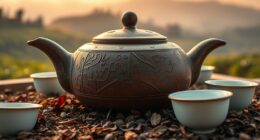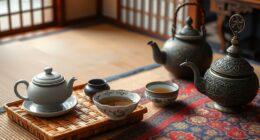Crafting hot matcha tea is akin to producing a masterpiece. It demands meticulousness, expertise, and a keen eye for detail. However, once you’ve perfected the technique, you’re rewarded with a stunning and tasty beverage that’s perfect for sipping at any hour.
As someone who has been drinking matcha tea for years, I can attest to its numerous health benefits and unique taste profile. From boosting metabolism to providing a calming effect on the mind and body, matcha tea truly is a wonder beverage.
In this article, I will guide you through the process of making hot matcha tea step by step so that you too can experience its magic in your own home.
Key Takeaways
- Making hot matcha tea requires patience and skill, as well as high-quality matcha powder, hot water, a bamboo whisk, and a ceramic bowl.
- Matcha tea has a unique taste profile and is known for its health benefits, including boosting metabolism, improving brain function, and reducing stress levels.
- The ideal water temperature for making hot matcha tea is 175°F, and it’s important to use filtered or spring water to prevent contamination.
- Matcha tea can be customized with sweeteners, different types of milk, spices or flavored syrups, and even fruits, but it’s important to store it properly to avoid clumps and bitterness.
Overview of Matcha Tea
Now, let’s dive into the world of matcha tea – you’ll be transported to a serene Japanese garden as we explore this delicious and vibrant beverage.
Matcha tea is made from finely ground green tea leaves that are grown in shade for several weeks before being hand-picked and stone-ground into a fine powder. This traditional Japanese drink has been around for centuries and is known for its unique taste and numerous health benefits.
The history of matcha tea dates back to ancient Japan, where it was used in traditional tea ceremonies as a symbol of harmony, respect, and tranquility. Over time, matcha became popular among samurai warriors who believed it gave them energy and mental clarity during battles.
Today, matcha is enjoyed all over the world for its rich flavor and various health benefits such as boosting metabolism, improving brain function, reducing stress levels, and lowering cholesterol.
If you’re interested in making hot matcha tea at home, gathering your materials is the first step. But before we get into that, let’s explore more about the amazing health benefits of this superfood beverage.
Gather Your Materials
To begin making hot matcha tea, I’ll gather the required ingredients and recommended tools.
For the ingredients, I’ll need high-quality matcha powder, hot water, and a sweetener of my choice.
As for tools, I recommend using a bamboo whisk (chasen), a ceramic bowl (chawan), and a measuring spoon to ensure accurate portions.
Required Ingredients
First things first, you’ll need some matcha powder and hot water to make a delicious cup of hot matcha tea! Matcha is available in different grades, ranging from culinary grade to ceremonial grade. If you want a more authentic taste experience, go for the latter as it has a sweeter flavor with less bitterness. However, if you’re only using it for cooking or baking purposes, then culinary grade is perfect.
Matcha is also known for its numerous health benefits such as being rich in antioxidants, boosting metabolism, and providing energy without the jitters that come with coffee. When selecting your matcha powder, choose one that’s organic and sourced directly from Japan.
Now that we have our ingredients sorted out, let’s move on to the recommended tools section.
Recommended Tools
Start your matcha journey off on the right foot by equipping yourself with the necessary tools – think of them as your matcha-making arsenal!
To make the perfect cup of hot matcha tea, there are a few essential accessories you’ll need to have on hand. First and foremost, invest in a high-quality bamboo whisk or chasen. This tool is used to mix the matcha powder and water together until it’s frothy and smooth.
Another important accessory is a sifter or strainer. You don’t want any lumps or clumps in your matcha, so using a sifter ensures that the powder is evenly distributed and free of any debris.
When it comes to choosing the best brands for these accessories, look for ones made in Japan as they tend to be of higher quality.
With all these tools at your disposal, you’re now ready to move onto heating up your water for brewing!
Heat Your Water
Before you begin, make sure to heat your water until it’s just below boiling. This is important as boiling temperature can actually ruin the taste of matcha by making it bitter. To achieve this ideal temperature, you can use a thermometer or simply watch for steam rising from the pot.
Once your water is heated, there are a few teapot options that work well for preparing matcha tea. One popular choice is a ceramic teapot with a built-in strainer, which allows for easy brewing and straining in one container. Another option is a traditional Japanese tea pot called a kyusu, which typically has a fine mesh strainer inside the spout to catch any particles before pouring into cups.
If you don’t have either of these options on hand, don’t worry! You can also use any type of small pot or saucepan to heat your water and strain through a fine mesh sieve when pouring into your cup.
Now that your water is heated and you have chosen your preferred teapot method, it’s time to move onto measuring out your matcha powder.
Measure Your Matcha
It’s crucial to accurately measure out the amount of matcha powder you’ll be using in order to achieve the perfect balance of flavor and nutrients. Matcha grading is important when selecting which type of matcha powder to use. The highest grade, ceremonial grade, is made from young tea leaves that are shade-grown for several weeks before being harvested. This results in a vibrant green color and a rich, smooth taste. On the other hand, culinary grade matcha is less expensive and has a more bitter taste than ceremonial grade.
To ensure that you’re measuring your matcha correctly, it’s important to follow some simple measuring tips. First off, make sure that your measuring spoon or scoop is clean and dry before use. Next, gently sift the matcha powder into your container or onto your spoon to avoid any clumps or lumps. Finally, level off the top of your scoop with a straight edge such as a knife or spatula.
Now that you’ve measured out your desired amount of matcha powder, it’s time to move on to whisking it into hot water. But first, let’s explore how to properly heat your water for making hot matcha tea.
Whisk Your Matcha
To create a frothy, delicious cup of matcha, you’re gonna wanna grab your bamboo whisk and get ready to stir up some magic. Whisking your matcha is a crucial step in achieving the perfect frothy consistency that makes matcha so unique.
Here are some tips to help you get it just right:
- Start by adding a small amount of hot water (around 1/4 cup) to your matcha powder in a bowl.
- Use the prongs of your bamboo whisk to gently break up any clumps in the powder.
Once the powder is smooth, begin whisking vigorously in a back-and-forth motion until bubbles form on the surface. Gradually add more hot water while continuing to whisk until you reach your desired consistency.
Be sure not to over-whisk or use too much force, as this can result in bitterness.
It’s important to note that different grades of matcha may require slightly different methods for whisking. For example, higher grade ceremonial matcha should be sifted before use and requires less water than lower grades. Experiment with different techniques and amounts until you find what works best for you.
Now that your matcha is perfectly whisked, it’s time to add your water and enjoy!
Add Your Water
After whisking your matcha, it’s time to add the water. The key to making a perfect cup of hot matcha tea is getting the water temperature and quality just right. I recommend using filtered or spring water for the best taste.
The ideal water temperature for matcha is around 175°F (80°C). This is slightly cooler than boiling water, so be sure to let your kettle cool for a minute or two before pouring. If you don’t have a thermometer, you can also eyeball it by bringing the water to a boil and then letting it sit for a few minutes before adding it to your matcha.
In addition to the temperature, the quality of your water can also affect the taste of your hot matcha tea. Avoid using tap water if possible, as it may contain impurities that can alter the flavor. By using high-quality filtered or spring water, you’ll ensure that your matcha tastes its best.
Now that we’ve added our perfectly heated and filtered/springwater into our bowl with whisked Matcha powder in it, we’re ready to move on towards customizing our drink according to our preference!
Customize Your Matcha
Once you’ve added your water, it’s time to explore the endless possibilities of customizing your matcha to your liking and preferences. Don’t be afraid to experiment with different ingredients and techniques! Here are some ways to customize matcha:
-
Add sweeteners: Matcha can be quite bitter, so if you prefer a sweeter taste, add honey, agave syrup, or sugar.
-
Change the milk: If you’re not a fan of traditional dairy milk, try using almond or soy milk instead. These options will give your matcha a unique flavor that’s more suited to your taste.
-
Mix in spices: Adding cinnamon or nutmeg can give your matcha an entirely new dimension of flavor that’s both warm and comforting.
-
Use flavored syrups: Flavored syrups like vanilla or caramel can add a delicious twist to your matcha latte that’s sure to satisfy any sweet tooth.
Customizing matcha opens up a world of flavor variations that cater specifically to individual tastes and preferences.
Once you’ve made these adjustments, it’s time for the best part – serving and enjoying!
Serve and Enjoy
When it comes to serving matcha, there are traditional methods that have been followed for centuries. As someone who enjoys this tea myself, I find that these methods add an extra layer of authenticity to the experience.
However, there are also alternative ways to serve matcha that can be just as enjoyable and provide a unique twist on the traditional approach. Let’s explore both options in detail.
Traditional Serving Methods
Experience the true essence of Japanese culture by serving your hot matcha tea in traditional ceramic bowls, known as chawan. The tea ceremony, also known as chanoyu or sado, is an integral part of Japanese culture with a rich history and cultural significance. Serving matcha in a chawan is not only aesthetically pleasing but also enhances the flavor and aroma of the tea.
In order to fully appreciate the experience of drinking matcha from a chawan, it’s important to follow traditional serving methods. First, hold the chawan with both hands and admire its design. Then, rotate the bowl twice clockwise before taking a sip. After each sip, turn the bowl 180 degrees counterclockwise before taking another sip. This allows everyone at the gathering to view all sides of the bowl and appreciate its unique features.
Finally, after finishing your tea, admire the beauty of your empty cup before passing it along to the next person.
Transitioning into alternative serving suggestions, consider trying some modern twists on traditional matcha service. Such as using stylish glassware or adding foam milk for a latte-like experience.
Alternative Serving Suggestions
While traditional serving methods for hot matcha tea are often revered, there are also alternative ways to present this delightful beverage. For example, you might consider adding unique flavors to your matcha tea, such as mint or ginger. These additions can provide a refreshing twist on the classic taste of matcha while still maintaining its health benefits.
Another presentation idea is to serve iced matcha tea instead of hot. Simply prepare your matcha as usual and then pour it over ice for a refreshing summer treat. You could also experiment with different types of sweeteners like honey or agave syrup to add some sweetness without compromising the health benefits of the drink.
The possibilities are endless when it comes to making your own unique version of this beloved beverage. As you explore these alternative serving suggestions, it’s important to remember that proper storage is crucial in preserving the quality and freshness of your matcha powder.
Storing Your Matcha
As someone who loves matcha, it’s important to know how to properly store it. There are several key techniques that can help preserve the quality and flavor of your matcha for longer periods of time.
In this discussion, we’ll cover everything from proper storage techniques to understanding shelf life and expiration dates. So if you’re looking to get the most out of your matcha, read on!
Proper Storage Techniques
To ensure optimal freshness and flavor, it’s important to store your matcha tea in an airtight container in a cool, dry place. Proper storage techniques involve controlling the humidity levels of your storage area and using containers that prevent moisture from entering. This will help maintain the quality of your matcha for as long as possible.
Here are some tips for proper storage:
| Storage Tip | Description |
|---|---|
| Use Airtight Containers | To prevent moisture from entering, use airtight containers such as glass jars or metal tins with screw-on lids. |
| Store in Cool Areas | Heat can damage the quality of your matcha, so store it away from direct sunlight and heat sources like stoves or ovens. |
| Keep Away from Strong Odors | Matcha can easily absorb strong odors, so keep it away from items such as spices or coffee beans. |
| Check Expiration Dates | Matcha has a shelf life of around 6 months to a year depending on how well it is stored. Always check expiration dates before consuming to ensure freshness and safety. |
By following these proper storage techniques, you can extend the shelf life of your matcha tea while maintaining its quality and flavor. In the next section, we’ll discuss more about shelf life and expiration dates to help you determine when it’s time to replace old tea with fresh ones.
Shelf Life and Expiration Dates
You don’t want your precious green powder to go to waste, so let’s talk about how long you can keep it and when it’s time to toss it. While matcha tea has a longer shelf life compared to traditional teas, its quality will still deteriorate over time.
To ensure that your matcha remains fresh and flavorful, here are some tips for extending its shelf life:
- Store matcha in an airtight container away from direct sunlight and heat sources.
- Use a clean spoon or scoop when measuring out the powder to avoid contamination.
- Keep track of the expiration date and use within 6 months of opening.
Following these simple steps will not only extend the shelf life of your matcha but also maintain food safety. As with any food product, consuming expired or contaminated matcha can lead to health issues.
In the next section, I’ll share some tips and tricks on how to make hot matcha tea that will have you enjoying every sip.
Tips and Tricks
When it comes to making matcha tea, there are a few common issues that may arise, such as clumping or bitterness. In this subtopic, I’ll share some troubleshooting tips to help you overcome these issues and make the perfect cup of matcha.
Additionally, I’ll discuss experimenting with different techniques and flavors to enhance your matcha experience and discover new ways to enjoy this delicious drink.
Troubleshooting Common Issues
Uh-oh, something’s not quite right with your matcha tea? Let’s troubleshoot some common issues so you can enjoy a perfectly smooth and delicious cup.
One common issue is clumpy matcha powder. This can happen if the powder has been stored improperly or if it has been exposed to moisture. To prevent this, make sure to store your matcha in an airtight container in a cool, dry place. If you do encounter clumps, try sifting the powder before adding hot water or using a whisk to break up any lumps.
Another potential issue is bitterness in your matcha tea. This can be caused by using too much powder or water that is too hot. To avoid this, measure out your matcha carefully and use water that is around 175°F (80°C). You may also want to adjust the amount of honey or sugar you add for sweetness.
With these troubleshooting tips in mind, you’re ready to experiment with different techniques and flavors to find the perfect cup of hot matcha tea for you!
Experimenting with Different Techniques and Flavors
Indulge in your adventurous side and explore the wide variety of techniques and flavors that can be incorporated into your matcha experience. Matcha tea is a versatile beverage that allows for endless flavor combinations and brewing methods to suit your taste preferences.
Some popular techniques include adding milk or honey to enhance the sweetness, blending with fruits like strawberries or blueberries for a fruity twist, or even incorporating spices such as cinnamon or ginger for added depth.
When it comes to brewing methods, there are traditional ways such as using a bamboo whisk or modern gadgets like electric frothers. Each method produces a different texture and taste profile, so it’s worth experimenting with different techniques to find the perfect matcha blend that suits you.
Don’t be afraid to mix and match flavors and methods until you find what works best for you. With just a bit of creativity, you can elevate your hot matcha tea experience to new heights!
Frequently Asked Questions
What is the difference between matcha tea and regular green tea?
Matcha tea is a type of green tea that is made by grinding high-quality green tea leaves into a fine powder. The difference between matcha and regular green tea lies in the way they are produced and consumed.
While both types of teas come from the same plant, matcha is grown in shade for several weeks before harvesting to increase chlorophyll content, resulting in its vibrant green color. Matcha also has a more concentrated flavor profile compared to regular green tea due to the entire leaf being consumed rather than just steeping the leaves in hot water.
Matcha comes in different grades, with ceremonial grade being the highest quality and most expensive due to its delicate flavor and texture. Culinary grade matcha, on the other hand, is lower quality but still suitable for cooking or making lattes.
In contrast, regular green tea can vary widely depending on how it was processed and brewed but generally has a milder taste compared to matcha.
Can you use cold water to make matcha tea?
Yes, it’s possible to use cold water to make matcha tea. However, using cold water may affect the quality of the matcha compared to using hot water. Matcha powder needs to be dissolved in water, and using cold water may not dissolve it properly, resulting in a grainy texture and bitter taste.
Additionally, hot water helps bring out the flavor and aroma of matcha. Therefore, if you want to enjoy high-quality matcha tea with a smooth texture and rich flavor profile, it’s recommended to use hot water instead of cold water.
How long does matcha tea stay fresh for?
As someone who regularly drinks matcha tea, I can attest to the importance of storing it properly to ensure its freshness. Matcha tea has a relatively short shelf life, typically lasting up to six months when stored in an airtight container away from direct sunlight and moisture.
It’s essential to avoid exposing the powder to air as much as possible since this can cause it to lose its flavor and potency quickly.
If you find yourself with old matcha powder that has lost its vibrancy, there are still ways you can use it effectively. For example, you could add it to smoothies or baked goods for a subtle matcha flavor boost.
Alternatively, using older matcha powder for cooking savory dishes such as sauces or marinades is another great way to get some use out of it before it goes bad.
In summary, proper storage is crucial for ensuring the freshness of your matcha tea powder, but don’t let old powder go entirely unused – get creative with how you incorporate it into various recipes!
What are the health benefits of drinking matcha tea?
Drinking matcha tea has numerous health benefits, making it a popular beverage choice for many people. Some of the most significant benefits include its ability to boost metabolism and aid in weight loss, due to the high levels of antioxidants and catechins present in the tea.
Matcha tea also contains L-theanine, which can help reduce stress and promote relaxation without causing drowsiness. Additionally, drinking matcha tea may improve brain function by enhancing cognitive performance and increasing alertness.
There are many ways to enjoy matcha tea recipes beyond just hot beverages, including adding it to smoothies or using it as an ingredient in baked goods. Overall, incorporating matcha tea into your diet is a delicious way to reap its numerous health benefits.
Can you add milk to matcha tea?
Yes, you can add milk to matcha tea. This combination is known as a Matcha latte and has become increasingly popular in recent years.
Adding milk to matcha tea not only enhances its creaminess but also balances out the bitterness of the tea. The most common type of milk used is steamed or frothed milk, such as almond or soy milk, but regular dairy milk can also be used.
It’s important to note that adding too much milk can overpower the flavor of the matcha, so it’s best to add just a small amount at a time until desired taste is achieved.
Overall, a Matcha latte is a delicious and healthy alternative to traditional coffee drinks.
Conclusion
Well, folks, I hope this guide on how to make hot matcha tea has been helpful.
Now you too can join the ranks of trendy Instagram influencers and pretend like you’re a Japanese tea master.
But let’s be real, it’s not just about the aesthetic – matcha is actually pretty tasty and has some health benefits too.
Of course, if you don’t have the patience to measure out your matcha or whisk it properly, feel free to grab a pre-made latte from Starbucks and call it a day.
And if all else fails, just stick with your regular cup of coffee – after all, who needs antioxidants and natural caffeine when you can have artificial flavors and sugar instead?
Cheers!



